Information injection-pump assembly
BOSCH
9 400 611 850
9400611850
ZEXEL
107492-0106
1074920106
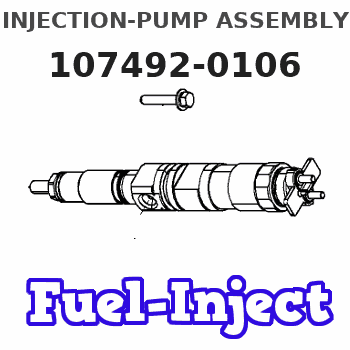
Rating:
Service parts 107492-0106 INJECTION-PUMP ASSEMBLY:
1.
_
5.
AUTOM. ADVANCE MECHANIS
6.
COUPLING PLATE
9.
_
11.
Nozzle and Holder
16600-29D01
12.
Open Pre:MPa(Kqf/cm2)
19.6{200}
15.
NOZZLE SET
Include in #1:
107492-0106
as INJECTION-PUMP ASSEMBLY
Cross reference number
BOSCH
9 400 611 850
9400611850
ZEXEL
107492-0106
1074920106
Zexel num
Bosch num
Firm num
Name
Calibration Data:
Adjustment conditions
Test oil
1404 Test oil ISO4113 or {SAEJ967d}
1404 Test oil ISO4113 or {SAEJ967d}
Test oil temperature
degC
40
40
45
Nozzle and nozzle holder
105780-8250
Bosch type code
1 688 901 101
Nozzle
105780-0120
Bosch type code
1 688 901 990
Nozzle holder
105780-2190
Opening pressure
MPa
20.7
Opening pressure
kgf/cm2
211
Injection pipe
Outer diameter - inner diameter - length (mm) mm 8-3-600
Outer diameter - inner diameter - length (mm) mm 8-3-600
Overflow valve
131425-0520
Overflow valve opening pressure
kPa
255
221
289
Overflow valve opening pressure
kgf/cm2
2.6
2.25
2.95
Tester oil delivery pressure
kPa
255
255
255
Tester oil delivery pressure
kgf/cm2
2.6
2.6
2.6
PS/ACT control unit part no.
407910-3
03*
Selector switch no.
02
PS/ACT control unit part no.
407980-2
24*
Digi switch no.
01
Direction of rotation (viewed from drive side)
Right R
Right R
Injection timing adjustment
Direction of rotation (viewed from drive side)
Right R
Right R
Injection order
1-3-4-2
Pre-stroke
mm
5.6
5.57
5.63
Beginning of injection position
Drive side NO.1
Drive side NO.1
Difference between angles 1
Cal 1-3 deg. 90 89.75 90.25
Cal 1-3 deg. 90 89.75 90.25
Difference between angles 2
Cal 1-4 deg. 180 179.75 180.25
Cal 1-4 deg. 180 179.75 180.25
Difference between angles 3
Cyl.1-2 deg. 270 269.75 270.25
Cyl.1-2 deg. 270 269.75 270.25
Injection quantity adjustment
Adjusting point
-
Rack position
13.9
Pump speed
r/min
900
900
900
Average injection quantity
mm3/st.
104.5
102.5
106.5
Max. variation between cylinders
%
0
-4
4
Basic
*
Fixing the rack
*
PS407980-224*
V
2.25+-0.
01
PS407980-224*
mm
3.6+-0.0
5
PS407910-303*
V
2.25+-0.
01
PS407910-303*
mm
3.6+-0.0
5
Standard for adjustment of the maximum variation between cylinders
*
Injection quantity adjustment_02
Adjusting point
Z
Rack position
7.5+-0.5
Pump speed
r/min
550
550
550
Average injection quantity
mm3/st.
12
10.2
13.8
Max. variation between cylinders
%
0
-10
10
Fixing the rack
*
PS407980-224*
V
V1+0.05+
-0.01
PS407980-224*
mm
5.5+-0.0
3
PS407910-303*
V
V1+0.05+
-0.01
PS407910-303*
mm
5.5+-0.0
3
Standard for adjustment of the maximum variation between cylinders
*
Remarks
Refer to items regarding the pre-stroke actuator
Refer to items regarding the pre-stroke actuator
Injection quantity adjustment_03
Adjusting point
A
Rack position
R1(13.9)
Pump speed
r/min
900
900
900
Average injection quantity
mm3/st.
104.5
103.5
105.5
Basic
*
Fixing the lever
*
Boost pressure
kPa
40
40
Boost pressure
mmHg
300
300
PS407980-224*
V
2.25+-0.
01
PS407980-224*
mm
3.6+-0.0
5
PS407910-303*
V
2.25+-0.
01
PS407910-303*
mm
3.6+-0.0
5
Injection quantity adjustment_04
Adjusting point
B
Rack position
R1+3.15
Pump speed
r/min
1400
1400
1400
Average injection quantity
mm3/st.
120.5
116.5
124.5
Fixing the lever
*
Boost pressure
kPa
40
40
Boost pressure
mmHg
300
300
PS407980-224*
V
2.25+-0.
01
PS407980-224*
mm
3.6+-0.0
5
PS407910-303*
V
2.25+-0.
01
PS407910-303*
mm
3.6+-0.0
5
Injection quantity adjustment_05
Adjusting point
C
Rack position
(R2-2.2)
Pump speed
r/min
500
500
500
Average injection quantity
mm3/st.
66
64
68
Fixing the lever
*
Boost pressure
kPa
0
0
0
Boost pressure
mmHg
0
0
0
PS407980-224*
V
2.25+-0.
01
PS407980-224*
mm
3.6+-0.0
5
PS407910-303*
V
2.25+-0.
01
PS407910-303*
mm
3.6+-0.0
5
Boost compensator adjustment
Pump speed
r/min
500
500
500
Rack position
(R2-2.2)
Boost pressure
kPa
9.3
8
10.6
Boost pressure
mmHg
70
60
80
Boost compensator adjustment_02
Pump speed
r/min
500
500
500
Rack position
R2(R1-1.
25)
Boost pressure
kPa
26.7
26.7
26.7
Boost pressure
mmHg
200
200
200
0000001601
CU407980-224*
*
Actuator retarding type
*
Supply voltage
V
12
11.5
12.5
Ambient temperature
degC
23
18
28
Pre-stroke
mm
2.5
2.45
2.55
Output voltage
V
2.83
2.82
2.84
Adjustment
*
_02
CU407980-224*
*
Supply voltage
V
12
11.5
12.5
Ambient temperature
degC
23
18
28
Pre-stroke
mm
5.6
5.57
5.63
Output voltage
V
1.2
1
1.4
Confirmation
*
Remarks
Output voltage V1
Output voltage V1
_03
CU407980-224*
*
Supply voltage
V
12
11.5
12.5
Ambient temperature
degC
23
18
28
Output voltage
V
3.05
3.05
Confirmation of operating range
*
_04
CU407910-303*
*
Actuator retarding type
*
Supply voltage
V
12
11.5
12.5
Ambient temperature
degC
23
18
28
Pre-stroke
mm
2.5
2.45
2.55
Output voltage
V
2.83
2.82
2.84
Adjustment
*
_05
CU407910-303*
*
Supply voltage
V
12
11.5
12.5
Ambient temperature
degC
23
18
28
Pre-stroke
mm
5.6
5.57
5.63
Output voltage
V
1.2
1
1.4
Confirmation
*
Remarks
Output voltage V1
Output voltage V1
_06
CU407910-303*
*
Supply voltage
V
12
11.5
12.5
Ambient temperature
degC
23
18
28
Output voltage
V
3.05
3.05
Confirmation of operating range
*
Test data Ex:
Governor adjustment
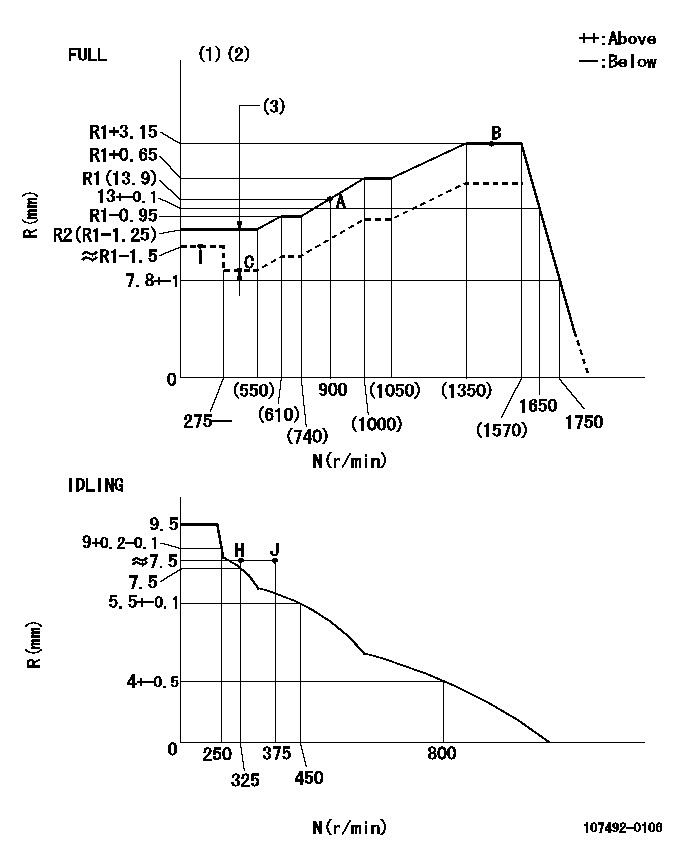
N:Pump speed
R:Rack position (mm)
(1)Torque cam stamping: T1
(2)Tolerance for racks not indicated: +-0.05mm.
(3)Boost compensator stroke: BCL
----------
T1=AG08 BCL=(2.2)mm
----------
----------
T1=AG08 BCL=(2.2)mm
----------
Speed control lever angle

F:Full speed
I:Idle
(1)Use the pin at R = aa
(2)Stopper bolt set position 'H'
----------
aa=58mm
----------
a=22.5deg+-5deg b=41.5deg+-3deg
----------
aa=58mm
----------
a=22.5deg+-5deg b=41.5deg+-3deg
Stop lever angle
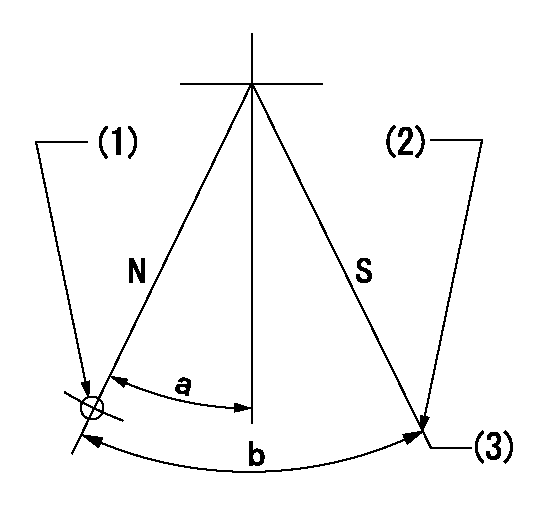
N:Pump normal
S:Stop the pump.
(1)Use the pin at R = aa
(2)Stopper bolt setting
(3)Rack position = bb (speed = cc)
----------
aa=34mm bb=1.5+-0.3mm cc=0r/min
----------
a=22.5deg+-5deg b=45deg+-5deg
----------
aa=34mm bb=1.5+-0.3mm cc=0r/min
----------
a=22.5deg+-5deg b=45deg+-5deg
0000001301

(1)Pump vertical direction
(2)Position of coupling's standard threaded hole at No 1 cylinder's beginning of injection
(3)A.T.D.C: aa
(4)Pre-stroke: bb
----------
aa=2deg bb=5.6+-0.03mm
----------
a=(50deg)
----------
aa=2deg bb=5.6+-0.03mm
----------
a=(50deg)
0000001401
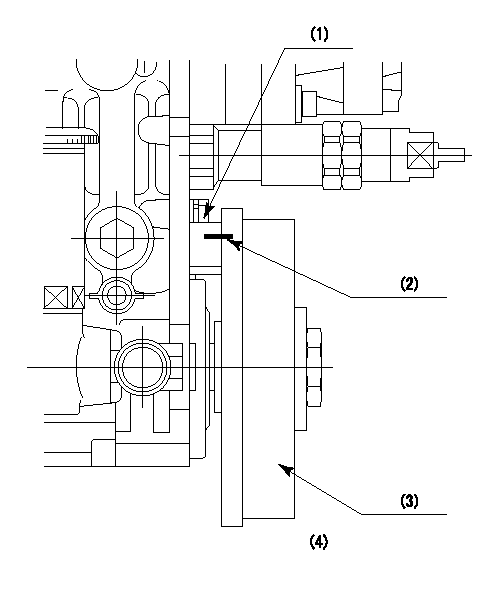
(1)Pointer
(2)Injection timing aligning mark
(3)Fly weight
(4)The actual shape and direction may be different from this illustration.
Operation sequence
1. Turn the prestroke actuator OFF.
2. Turn the camshaft as far as the No.1 cylinder's beginning of injection position.
3. Check that the pointer alignment mark of the injection pump and the alignment mark of the flywheel are matching.
4. If they are not matching, erase the alignment mark on the flywheel side, and stamp an alignment mark on the flywheel position that matches with the pointer side alignment mark.
5. Check again that the coupling's key groove position is in the No.1 cylinder's beginning of injection position.
----------
----------
----------
----------
0000001701
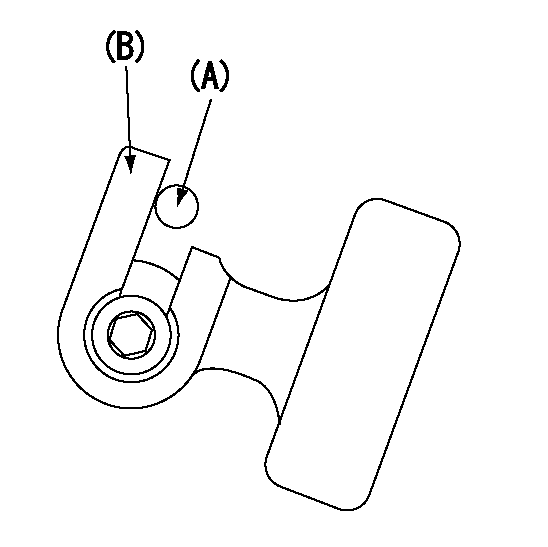
A : Stopper pin
B: Connector
----------
----------
----------
----------
0000001801
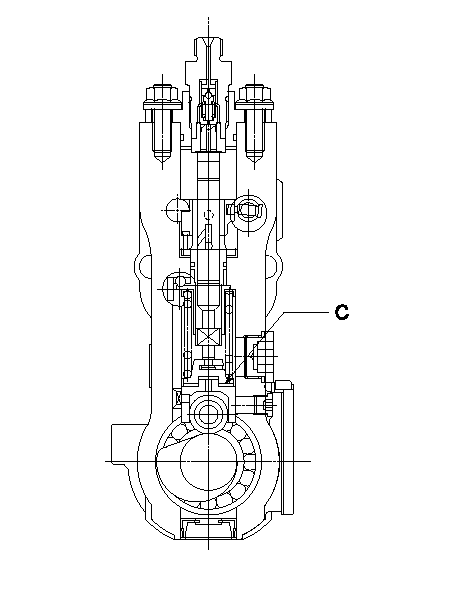
C:Shim
----------
----------
----------
----------
0000001901
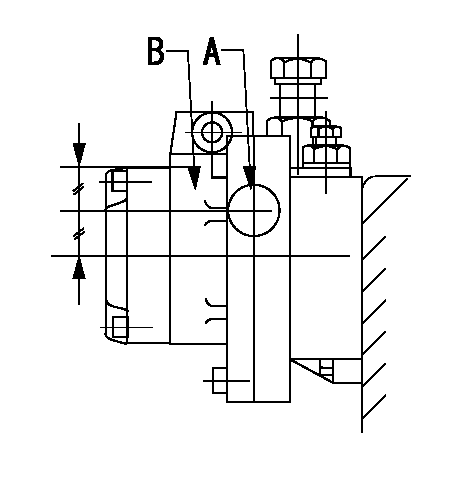
A:Sealing position
B:Pre-stroke actuator
1. When installing the pre-stroke actuator on the pump, first tighten the installation bolts loosely, then move the actuator fully counterclockwise (viewed from the drive side).
Temporary tightening torque: 1 - 1.5 N.m (0.1 - 0.15 kgf.m)
2. Move the actuator in the clockwise direction when viewed from the drive side, and adjust so that it becomes the adjustment point of the adjustment value. Then tighten it.
Tightening torque: 7^9 N.m (0.7^0.9 kgf.m)
3. After prestroke actuator installation adjustment, simultaneously stamp both the actuator side and housing side.
----------
----------
----------
----------
0000002201 RACK SENSOR
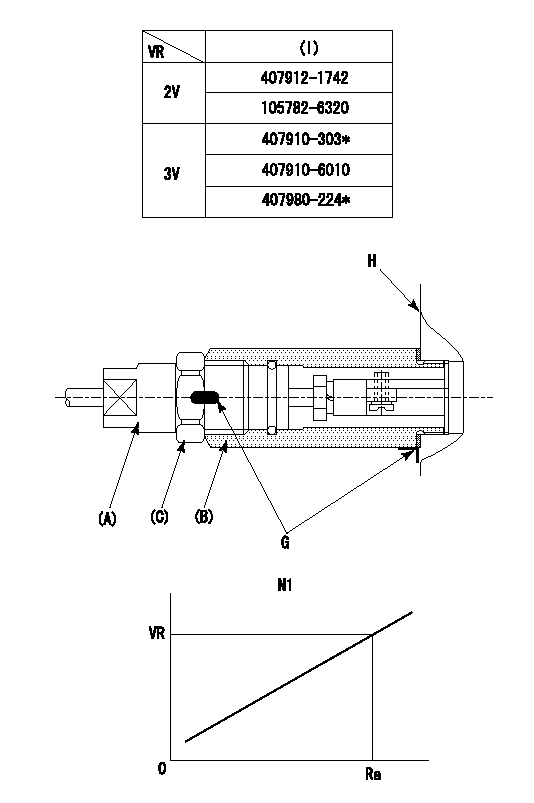
(VR) measurement voltage
(I) Part number of the control unit
(G) Apply red paint.
(H): End surface of the pump
1. Rack sensor adjustment (-0620)
(1)Fix the speed control lever at the full position
(2)Set the speed to N1 r/min.
(If the boost compensator is provided, apply boost pressure.)
(3)Adjust the bobbin (A) so that the rack sensor's output voltage is VR+-0.01.
(4)At that time, rack position must be Ra.
(5)Apply G at two places.
Connecting part between the joint (B) and the nut (F)
Connecting part between the joint (B) and the end surface of the pump (H)
----------
N1=1400r/min Ra=R1+3.15mm
----------
----------
N1=1400r/min Ra=R1+3.15mm
----------
0000002301 ACS
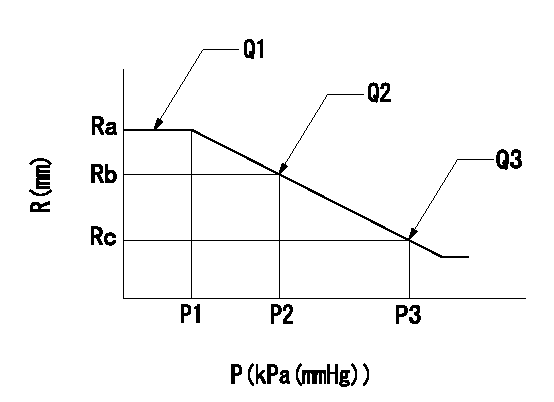
(P) Absolute pressure
(R) Rack position (mm)
1. Adjustment of the aneroid compensator
(1)Screw in the aneroid compensator body and attach the pushrod to the compensator lever so that the performance in the above graph can be obtained. The control lever must be at the full set position N = N1.
----------
N1=1400r/min
----------
Ra=R3(R1+3.15)mm Rb=(R3-0.25)mm Rc=R3-0.75mm P1=(93.2)kPa((699)mmHg) P2=84.5+-2.7kPa(634+-20mmHg) P3=70.1+-0.7kPa(526+-5mmHg) Q1=(120.5)+-2mm3/st Q2=(116.5)mm3/st Q3=(112)mm3/st
----------
N1=1400r/min
----------
Ra=R3(R1+3.15)mm Rb=(R3-0.25)mm Rc=R3-0.75mm P1=(93.2)kPa((699)mmHg) P2=84.5+-2.7kPa(634+-20mmHg) P3=70.1+-0.7kPa(526+-5mmHg) Q1=(120.5)+-2mm3/st Q2=(116.5)mm3/st Q3=(112)mm3/st
0000002401 POTENTIO METER
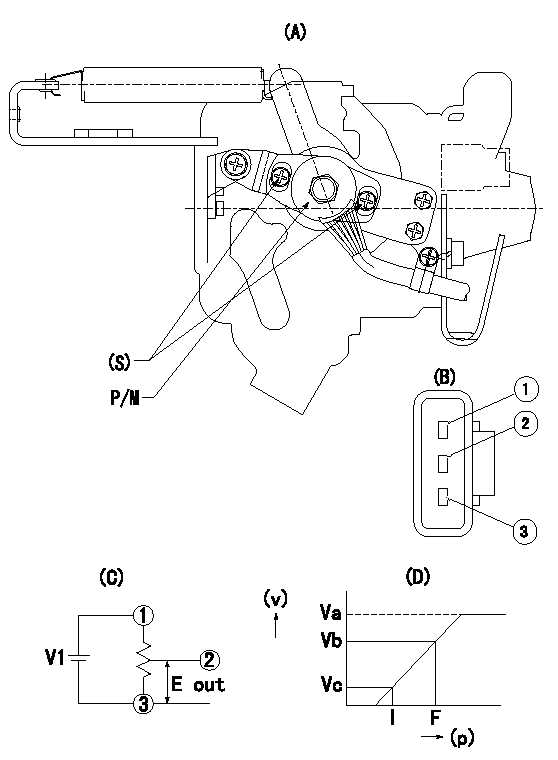
(A) : Governor plan view
(B): Potentiometer harness terminal
(C): Potentiometer connection diagram
(D) : Output voltage standard value
(S): Voltage
P/M: potentiometer
(v): output voltage (V)
(p): direction of potentiometer rotation
1. Adjustment procedures
(1)Apply DCV1 to potentiometer harness terminal (B) to obtain the specified output voltage.
(2)Fix the speed lever at the full side.
(3)Loosen the bolt (S), and move the potentiometer from left and right.
(4)Adjust so that the output voltage at full is within the standard values.
(5)Fix bolt (S).
(6)Repeatedly move the speed lever from the full side to the idle side.
(7)Check that it is within the standard values at full and idle.
----------
V1=5+-0.02V
----------
V1=5+-0.02V Va=(5)V Vb=4.3+-0.05V Vc=-
----------
V1=5+-0.02V
----------
V1=5+-0.02V Va=(5)V Vb=4.3+-0.05V Vc=-
Information:
Illustration 1 g00565249The test for the water temperature contactor switch is a test for the temperature on the switch actuator and an electrical continuity test. This test will determine if the water temperature contactor switch is faulty and if the switch should be replaced. Use the 4C-6500 Digital Thermometer and the 4C-6500 Digital Thermometer for this test.
Install a probe from the 4C-6500 Digital Thermometer in the water manifold as close as possible to the water temperature contactor switch. Disconnect the connector for the water temperature contactor switch from the junction box. Note: Do not remove the water temperature contactor switch from the engine in order to conduct this test. The water temperature contactor switch uses the coolant flow and the coolant temperature in order to activate the switch at the actuation temperature.
When the water temperature contactor switch is disconnected from the junction box and the engine is stopped, check the continuity across the contact (WTS-3) and the common contact (WTS-2). Continuity should exist. This indicates that the circuit is closed across the contacts. Check the continuity across contact (WTS-1) and the common contact (WTS-2). Continuity should not exist. This indicates that the circuit is open across the contacts. If these conditions do not exist, the water temperature contactor switch is faulty and the switch needs to be replaced.
Start the engine. While the engine is running, place a load on the engine. Restrict the air flow to the engine. The engine should continue to run and the coolant temperature should increase to the actuation temperature of the water temperature contactor switch.
Observe the coolant temperature gauge in order to determine the temperature of the coolant when the actuation of the switch occurs. Compare the temperature on the gauge with the specifications for the water temperature contactor switch. The switch is actuated when the circuit across contacts (WTS-1) and (WTS-2) closes. The engine should shut down when the switch is actuated. This activates the protection system.
The actuation of the water temperature contactor switch may not occur when the temperature of the coolant is greater than the maximum value for the actuation temperature of the switch. Immediately reduce the load that is on the engine and remove the restriction to the air inlet. Allow the engine to run at idle until the temperature of the coolant returns to normal before you stop the engine.
The actual temperature of the coolant may not have been within the specifications of the water temperature contactor switch at the time of actuation. The switch is faulty and the switch needs to be replaced. Actuation might not occur when the temperature of the coolant is at the maximum. The switch is faulty and the switch needs to be replaced.